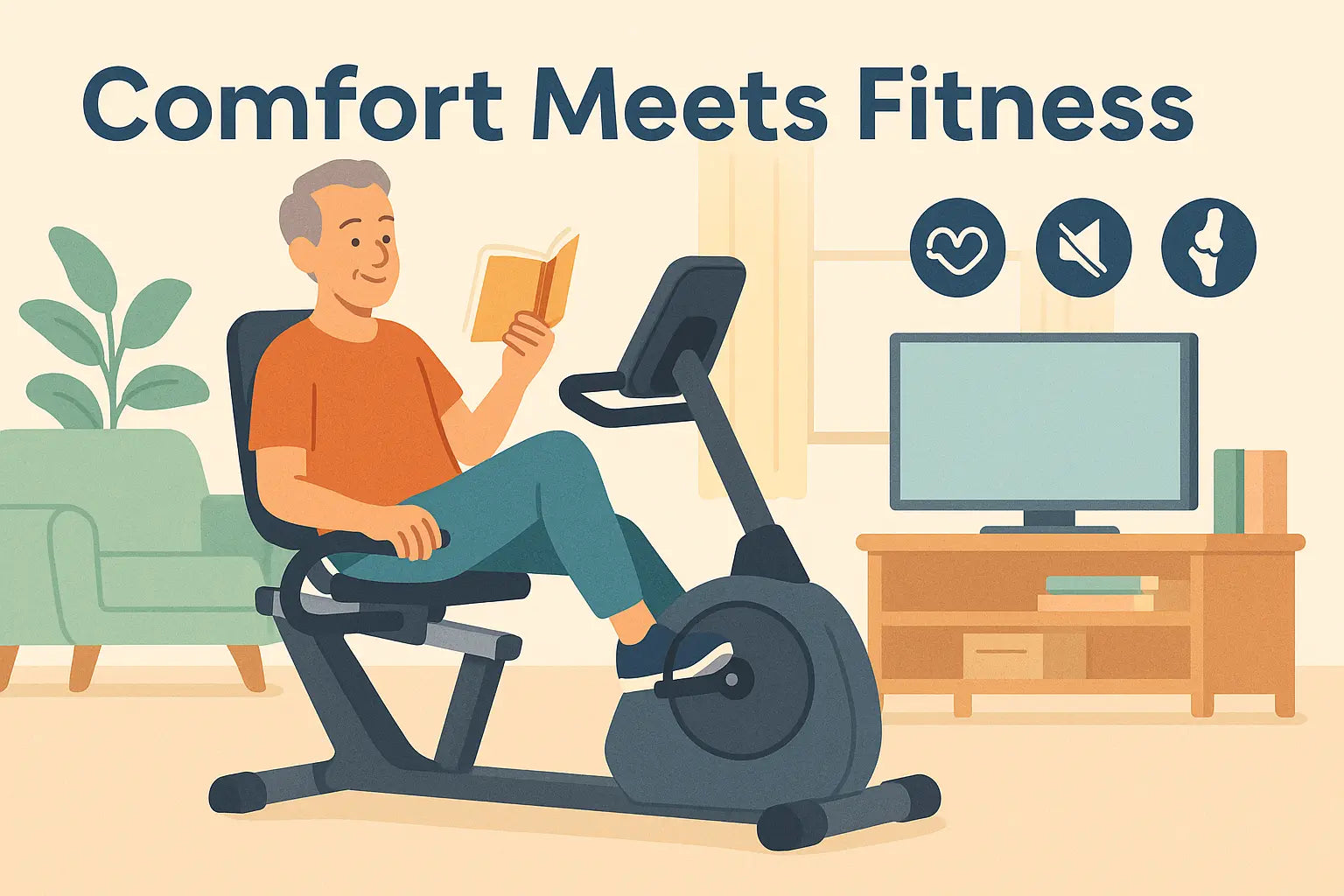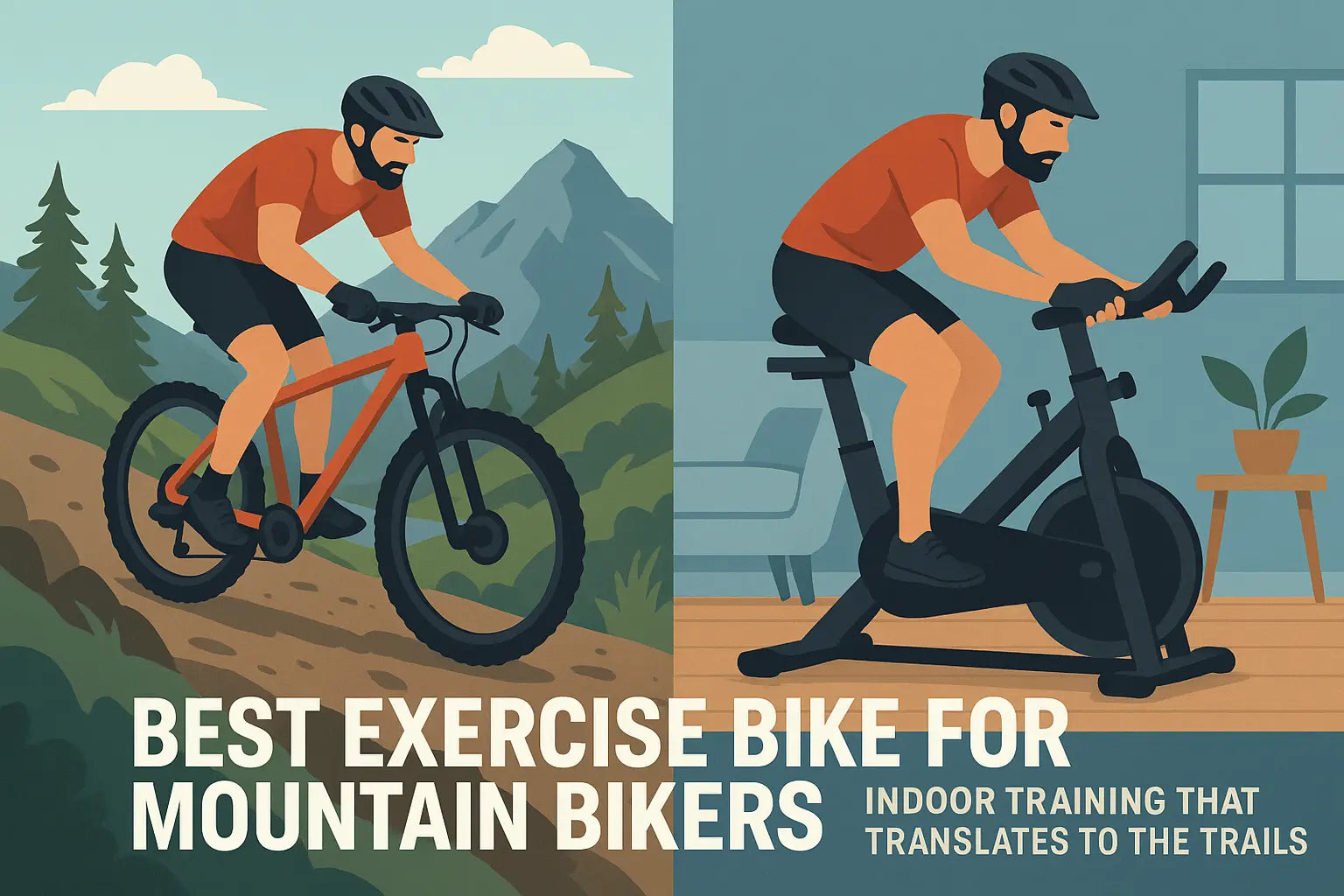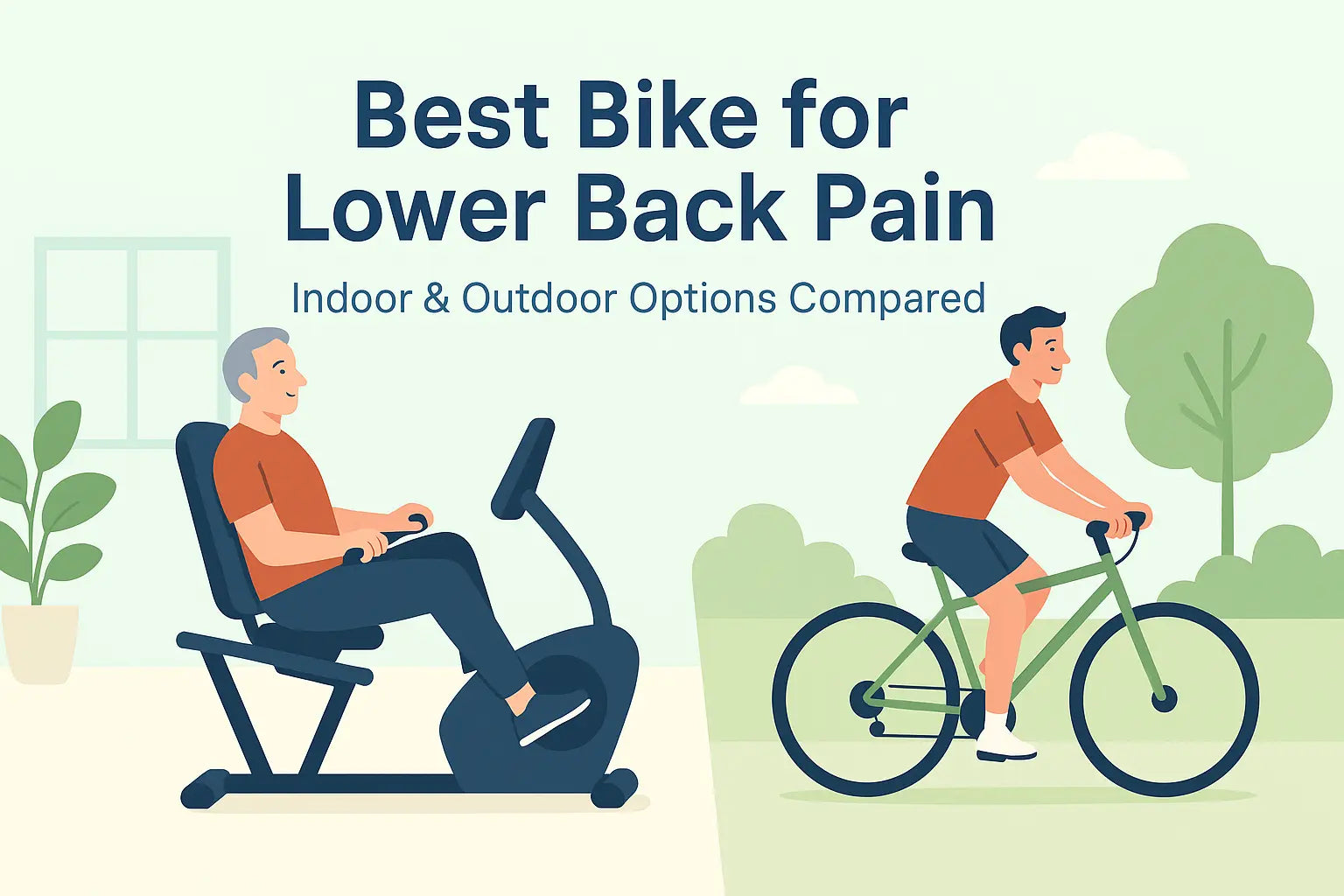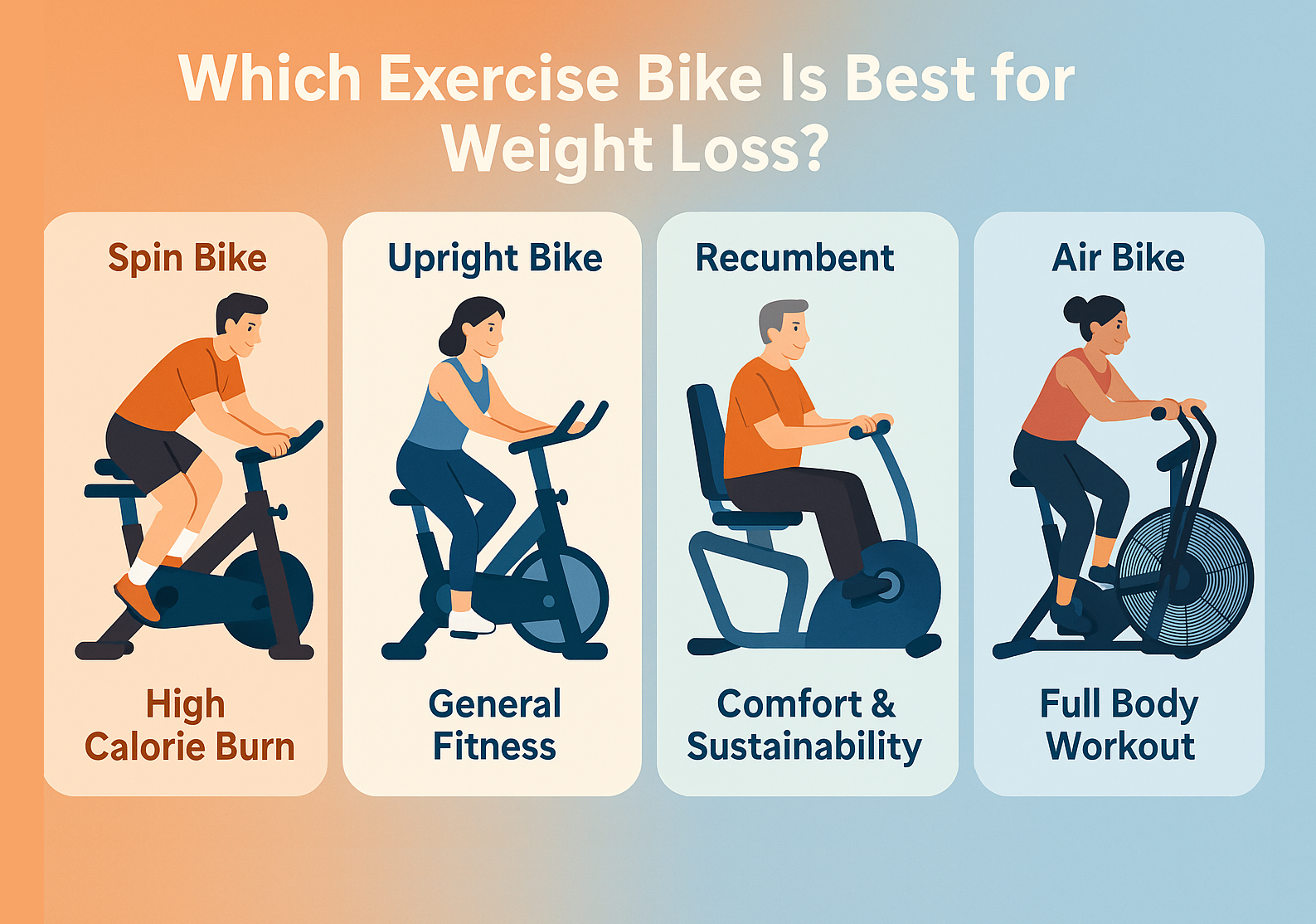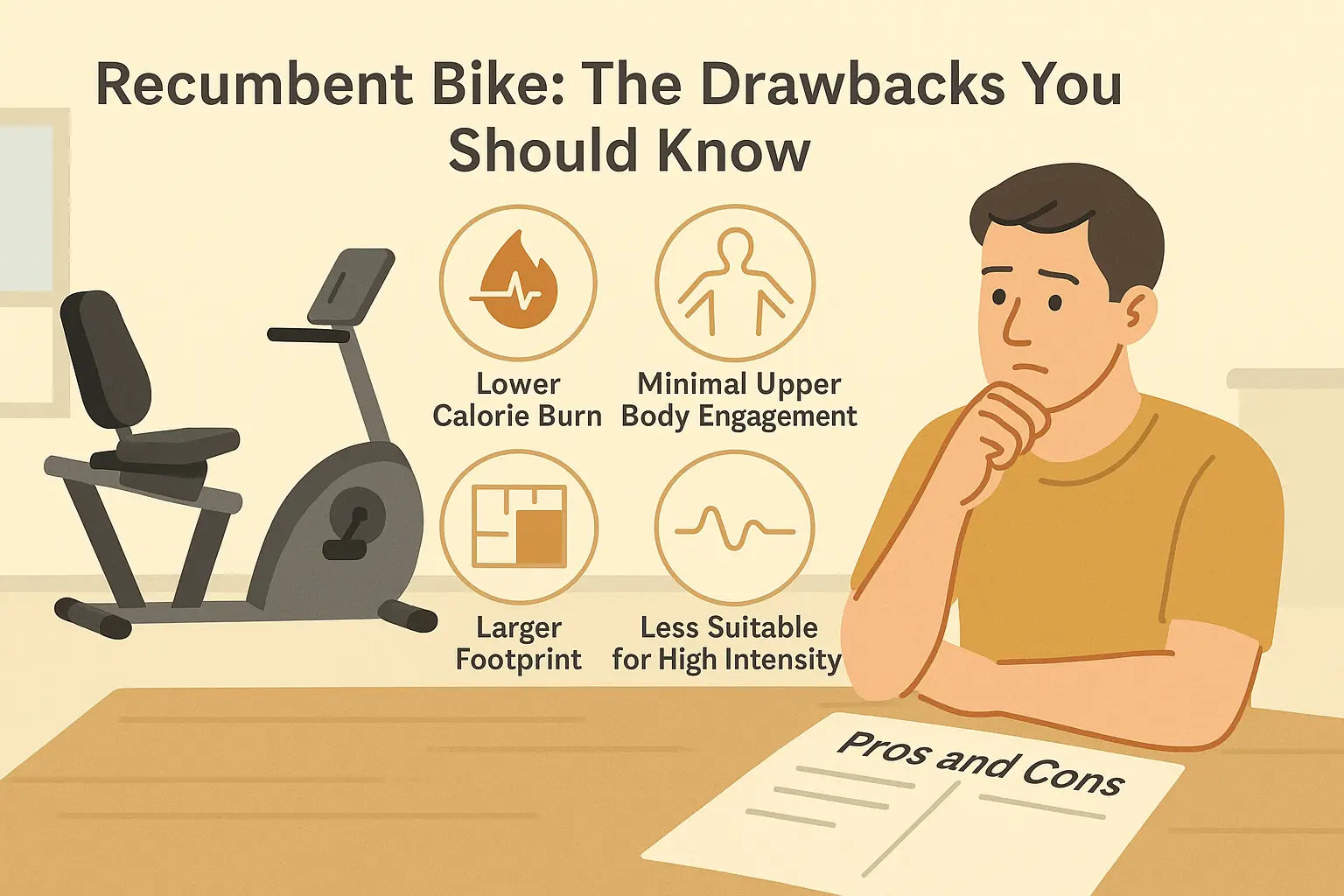You’re motivated to start biking at home—but should you lean back or sit up? With so many models out there, it’s easy to feel overwhelmed. Don’t worry. As a specialist in Vanswe Recumbent Bikes, I’ll walk you through the real differences between recumbent and upright bikes. Whether you're recovering from an injury, dealing with joint pain, or chasing a tough cardio workout, this guide will help you find the bike that fits your goals and lifestyle perfectly.
Recumbent Bike vs Upright Bike: Basic Info
Upright bikes originated from traditional road bicycles and were first used indoors by cyclists for off-season training. They became popular gym equipment in the 1970s for intense cardio workouts. In contrast, recumbent bikes were developed later with a focus on rehabilitation and ergonomic comfort, designed to reduce strain on the back and joints. Initially used in medical settings, they’ve since become a preferred option for seniors and users seeking low-impact exercise.
Although both are indoor cardio cycling machines, their structural designs differ significantly.
📊 Bike Structure
| Feature | Recumbent Bike | Upright Bike |
|---|---|---|
| Seating Position | Reclined seat with feet forward; full back support | Upright posture similar to a traditional bike; no backrest |
| Pedal Placement | Pedals positioned in front; horizontal leg movement reduces knee stress | Pedals under the hips; vertical pedaling mimics outdoor cycling |
| Handlebar Design | Dual handlebars — one in front, one on each side of the seat | Single front handlebar; requires forward lean to grip |
| Mounting Ease | Low, open frame allows easy access; ideal for seniors or limited mobility | Requires leg swing to mount; better for agile users |
Recumbent Bike vs Upright Bike: Key Difference
1. Comfort Differences
Upright bikes are modeled after traditional road bicycles—which also means they inherit the same posture-related discomforts. These discomforts are your body’s way of sounding the alarm. Ignoring them could lead to strain, injury, or long-term issues if left unaddressed.
According to the British Journal of Sports Medicine [1], studies show that 40% to 85% of cyclists experience some form of injury annually, ranging from overuse issues to acute trauma. Even among recreational riders, research indicates that about 36% report at least one cycling-related discomfort or injury each year. The most frequent problems are overuse injuries, particularly affecting the knees (up to 60%), lower back, neck, wrists, and the perineal area due to prolonged pressure or poor bike fit. Acute injuries are often caused by falls, collisions, or road hazards.
In contrast, most recumbent bikes offer ergonomic support, which enables users to maintain comfort over longer periods. These bikes feature a reclined seating position with legs extended in front, promoting a relaxed seating position that reduces strain on the back and joints. According to the National Institute on Aging [2], supportive exercise machines like recumbent bikes are ideal for older adults or those with back and joint issues.
In fact, recumbent bikes are widely recommended for hip/knee surgery recovery. Many of our customers have shared that they purchased their recumbent bikes following their doctor’s advice as part of their rehabilitation plan. You can check out real user reviews here from individuals recovering from knee, hip, or lower back surgeries.
2. Getting On and Off
According to the World Health Organization (WHO) and national health agencies [3], one in three adults over age 65 falls each year, and the risk increases to over 40% for those aged 80 and above. These falls often result in serious consequences such as hip fractures, head injuries, or long-term loss of independence. Many incidents occur during everyday movements—like stepping over obstacles or getting in and out of chairs or equipment. That’s why step-over height on exercise bikes plays a crucial role in safety, especially for older adults.
Upright bikes typically have a step-over height of 18 to 24 inches (45–60 cm), which requires users to lift one leg high over the frame—posing a challenge for those with limited mobility or balance issues. In contrast, recumbent bikes are designed with a step-through frame, requiring little to no leg lifting, similar to a standard chair. Take the Vanswe RB407 as an example—it has a step-over height of just 2 inches, requiring almost no leg lift. This makes it easier and safer for seniors to get on and off without risking a fall.
| Feature | Upright Bike | Recumbent Bike |
| Step-Over Height | 18–24 in (45–60 cm) | 0–5 in (Step-through design) |
| Seat Height | Similar to traditional bicycle | 16–22 in (40–55 cm) |
| Getting On/Off | Requires lifting leg over frame | Walk-in access, minimal effort |
| Fall Risk for Seniors | Higher due to mounting difficulty | Lower due to easy seat access |
3. Muscle Engagement and Workout Intensity
Both recumbent and upright bikes work the glutes, thighs, hamstrings, and calves, but upright bikes also engage the core, arms, shoulders, and back for a more full-body workout.
Upright bikes are designed to replicate traditional cycling, offering a vigorous workout that engages a wider range of muscles.
Upright bikes engage a wider range of muscles, including:
-
Biceps and triceps (through upright posture and handlebar support)
-
Shoulders and arms (from maintaining balance and grip)
-
Core and abs (due to the need for trunk stabilization)
-
Glutes, thighs, and calves (similar to recumbent bikes but with greater intensity)
In contrast, recumbent bikes primarily target muscles:
-
Quadriceps and hamstrings (via forward pedaling motion)
-
Glutes and calves (with less intensity than upright bikes)
-
Minimal upper body and core engagement due to the supported, reclined position
Research has found that upright bikes make your core and back muscles work harder than recumbent bikes, leading to better full-body engagement. (Bouillon et al., 2016 [4]).
This makes upright bikes ideal for people seeking a more comprehensive workout. The ability to engage different muscle groups ensures a challenging workout that can enhance overall fitness levels with the right fitness equipment.
That said, many recumbent bike manufacturers are making strides in full-body training features. Take our own brand, Vanswe, for example. In 2025, we launched the Vanswe 408—a hybrid recumbent bike and elliptical trainer. It preserves the low-impact comfort recumbent bikes are known for while adding upper body engagement, making it a more versatile, full-body workout option.
4. Impact on Joints
Joint problems are extremely prevalent among seniors, particularly in the knees. According to the Centers for Disease Control and Prevention (CDC) [5], over 49.6% of adults aged 65 and older have been diagnosed with arthritis, with the knee joint being the most commonly affected area. The National Council on Aging [6] also identifies osteoarthritis as one of the most widespread chronic conditions in older adults, commonly affecting the knees, hips, hands, and spine. Epidemiological studies show that between 33% and 50% of seniors experience persistent knee pain or mobility issues, often leading to difficulty walking, climbing stairs, or standing for long periods.
For older adults, choosing a workout machine that’s gentle on the joints isn’t just a preference—it’s essential. This is where upright bikes fall short. Recumbent bikes are easier on the joints for three key biomechanical reasons.
Less Stress on the Knees: Smaller Joint Angles, Lower Pressure
On an upright bike, your knees bend deeply with each pedal stroke—usually between 75° and 105°. This puts more pressure and friction on the kneecap and surrounding cartilage.
Recumbent bikes, however, allow your legs to extend forward, keeping the knee angle lower (around 45° to 70°).
Smaller angles mean less compression on the joint, which helps protect the cartilage and reduce long-term wear—especially important for people with arthritis or knee pain.
Neutral Hip Position: Less Strain on Hip Flexors
Upright bikes keep your hips in a flexed (bent) position, especially during high resistance workouts. This can overwork the hip flexors, like the iliopsoas and rectus femoris, and lead to tightness or pelvic tilt.
Recumbent bikes support a more neutral, relaxed hip angle, reducing the pull on those muscles and lowering the risk of hip impingement or lower back discomfort.
Better Spine and Pelvic Support: Backrest Reduces Strain
Upright bikes require you to lean forward, using your core muscles to stay stable. Over time, this posture can strain the lower back and misalign the pelvis.
Recumbent bikes include a supportive backrest, which helps stabilize the spine and pelvis, eases pressure on the discs, and is especially helpful for people with herniated discs, degenerative spine issues, or postural back pain.
5. Cardiovascular Benefits
Both upright and recumbent bikes improve cardiovascular health, but recumbent bikes do so with less joint stress and greater comfort.
Upright bikes are excellent for building endurance and improving cardiovascular fitness due to their more intense workout capabilities. These upright exercise bikes are designed to provide challenging workouts that can significantly enhance heart function and regulate blood pressure, making them a popular choice for fitness enthusiasts seeking to boost their cardiovascular health with an upright stationary bike through upright cycling.
Both upright and recumbent bikes can enhance cardiovascular health by improving heart function and regulating blood pressure, supported by the American Heart Association's recommendation [7]. Whether you prefer the intense workouts offered by upright bikes or the low impact cardio workout provided by recumbent bikes, both options can contribute to better heart health and overall cardiovascular fitness.
For older adults or those seeking a gentler workout, recumbent bikes provide excellent cardiovascular exercise with added comfort and support. Both exercise bikes and an exercise bike type can help you achieve your cardiovascular fitness goals, regardless of your fitness level. Incorporating cardio equipment into your routine can further enhance your workouts.
6. Weight Loss and Calorie Burning
Upright bikes burn more calories than recumbent bikes due to higher workout intensity, but recumbent bikes allow for longer, more comfortable workouts that support steady weight loss over time.
When it comes to calorie burning and weight loss, upright bikes have the edge due to:
-
Their higher calorie burn potential.
-
Engagement of a wider range of muscles, allowing for more intense workouts that can burn more calories overall.
-
The ability to perform high-intensity interval training (HIIT), which can lead to a higher calorie burn compared to steady-state workouts.
These factors make upright bikes ideal for those seeking significant weight loss, especially when comparing calorie burn over the same duration of time.
Recumbent bikes, though typically burning fewer calories per minute than upright bikes, are often easier to stick with for longer sessions. Most users find they can comfortably ride for 45 to 60 minutes, compared to shorter, more intense upright bike workouts. This longer duration can add up to more total calorie burn—especially for those with more flexible schedules. For a deeper look at how recumbent bikes support weight loss, check out our full article on the benefits of recumbent bikes for fat loss.
Source: American Council on Exercise (ACE) – “HIIT vs. Steady-State Training: Which One is Best for Your Clients??” [8]
7. Space and Price
As a recumbent bike specialist, part of my daily work involves tracking market trends and product data. Below is a comparison I compiled showing the top 10 best-selling recumbent and upright bikes on Amazon US for July 2025, including their footprints and price points.
Upright Bike Space & Price Table
| Price | Footprint | Type | SQFT |
| $209.99 | 40 x 22 | 6.11 | |
| $129.99 | 31.9 x 17.7 | Foldable | 3.92 |
| $189.99 | Unlabeled | ||
| $111.99 | 49 x 16 | Foldable | 5.44 |
| $123.49 | 27.56 x 15.95 | Foldable | 3.05 |
| $179.00 | 44.5 x 19.3 | 5.96 | |
| $136.99 | 34.65 x 12.29 | Foldable | 2.96 |
| $129.99 | 27.17 x 15.75 | Foldable | 2.97 |
| $799.00 | 48.7 x 21.2 | 7.17 | |
| $114.99 | 31.9 x 15.94 | Foldable | 3.53 |
Recumbent Bike Space & Price Table
| Price | Footprint | SQFT |
| 199.99 | 25.4 x 48.3 | 8.52 |
| 199.99 | 51.97 x 25 | 9.02 |
| 399.99 | 50 x 23 | 7.99 |
| 199.99 | Unlabeled | |
| 199.99 | 43 x 20 | 5.97 |
| 169.99 | 53 x 19.3 | 7.10 |
| 199.99 | 48.3 x 25.4 | 8.52 |
| 151.98 | 56 x 25 | 9.72 |
| 209.99 | 51.38 x 26.58 | 9.48 |
| 349.99 | 43 x 18.5 | 5.52 |
Note: The information in this chart is time-sensitive. It's common to see product specs decline as prices spiral downward.
Looking at the top 10 best-selling upright bikes, 4 are standard upright models, while 6 are foldable upright bikes. Foldable versions are notably more compact and budget-friendly compared to recumbent bikes. On the other hand, standard upright bikes and recumbent bikes are fairly similar in both size and price.
Foldable upright bikes typically have a footprint of 3 to 5 square feet and fold down to about 2 sqft for easy storage. Standard upright bikes usually take up 6 to 7 sqft, whereas recumbent bikes require a larger space—usually between 8 and 9 sqft.
In terms of pricing, foldable upright bikes average around $120, while both standard upright and recumbent bikes tend to sit near the $200 mark. This challenges the traditional belief that recumbent bikes are always more expensive—an impression likely formed back when they were primarily designed for commercial or rehabilitation use. Today, the market has evolved to offer more competitively priced options for home users.
Recumbent Bike vs Upright Bike: Which Is Suit For You
Choosing the right bike depends on your fitness goals and health conditions. Upright bikes may better build endurance and suit fitness enthusiasts and younger people without physical limitations. They offer a challenging workout that can significantly boost cardiovascular fitness.
Conversely, recumbent bikes benefit seniors aiming to enhance core strength and balance. Their comfort and support facilitate longer workout sessions, increasing calorie burn and fitness over time. Both recumbent and upright bikes effectively burn calories, with higher calorie burn potential rising with longer and more intense workouts.
When selecting a bike, consider factors such as your budget, available space, and the intensity of the workouts you plan to perform. Considering these factors will help you make an informed decision that aligns with your fitness goals and ensures a satisfying exercise experience.
Conclusion:
For seniors, recumbent bikes are better for comfort and joint support, while for young people, upright bikes are better for calorie burn and muscle engagement.
Ultimately, the choice between recumbent and upright bikes depends on your personal fitness goals, health conditions, and preferences. By considering the factors discussed in this guide, you can select the bike that best aligns with your needs and embark on a successful fitness journey.
FAQ
What is better a recumbent bike or an upright bike for knee rehab?
A recumbent bike is better than an upright bike for knee rehab because its reclined seat and forward pedals reduce joint strain while supporting proper leg alignment.
Reference
- Rooney, D., Sarriegui, I., & Heron, N. (2020). 'As easy as riding a bike': a systematic review of injuries and illness in road cycling. BMJ open sport & exercise medicine, 6(1), e000840. https://doi.org/10.1136/bmjsem-2020-000840
- National Institute on Aging. (2025, January 14). Exercising with chronic conditions. U.S. Department of Health & Human Services. https://www.nia.nih.gov/health/exercise-and-physical-activity/exercising-chronic-conditions
- Ikpeze, T. C., Glaun, G., McCalla, D., & Elfar, J. C. (2018). Geriatric Cyclists: Assessing Risks, Safety, and Benefits. Geriatric orthopaedic surgery & rehabilitation, 9, 2151458517748742. https://doi.org/10.1177/2151458517748742
-
Bouillon, L., Baker, R., Gibson, C., Kearney, A., & Busemeyer, T. (2016). COMPARISON OF TRUNK AND LOWER EXTREMITY MUSCLE ACTIVITY AMONG FOUR STATIONARY EQUIPMENT DEVICES: UPRIGHT BIKE, RECUMBENT BIKE, TREADMILL, AND ELLIPTIGO®. International journal of sports physical therapy, 11(2), 190–200. -
Theis, K. A., Murphy, L. B., Guglielmo, D., Boring, M. A., Okoro, C. A., Duca, L. M., & Helmick, C. G. (2021, October 8). Prevalence of arthritis and arthritis‑attributable activity limitation — United States, 2016–2018. Morbidity and Mortality Weekly Report, 70(40), 1401–1407. Retrieved from https://www.cdc.gov/mmwr/volumes/70/wr/mm7040a2.htm -
Ambrose, K. (2023, February 17). Why older adults shouldn’t ignore an osteoarthritis diagnosis. National Council on Aging. Retrieved from https://www.ncoa.org/article/why-older-adults-shouldnt-ignore-an-osteoarthritis-diagnosis/ - American Heart Association. (n.d.). American Heart Association recommendations for physical activity in adults and kids. https://www.heart.org/en/healthy-living/fitness/fitness-basics/aha-recs-for-physical-activity-in-adults
- Mayo Clinic Staff. (n.d.). Weight loss: Choosing a diet that's right for you. Mayo Clinic. https://www.mayoclinic.org/healthy-lifestyle/weight-loss/in-depth/weight-loss/art-20048466
Latest Articles


